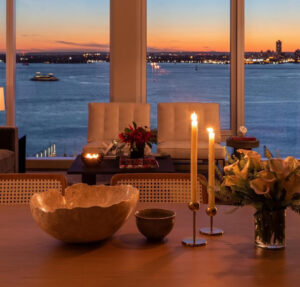From the shores of Sicily to the runways of Milan, HBO’s hit series changed the way we dress—and the way we escape.
In today’s fashion ecosystem, influence flows from everywhere—runways, TikTok, subcultures, nostalgia—but few sources have been as surprisingly dominant in recent years as television. And among them, The White Lotus stands alone.
The Emmy-winning HBO drama isn’t just prestige TV. It’s become a cultural mirror for wealth, desire, power, and escape. With each new season, viewers have become just as obsessed with the wardrobes as with the plot twists. Now, in 2025, The White Lotus isn’t simply a fashion inspiration—it’s a fashion moment, reshaping what luxury looks and feels like for a global audience hungry for style with narrative depth.
From its slow-burn tension and biting social commentary to its cinematography and character design, The White Lotus has blurred the lines between screen fantasy and real-world aspiration. And nowhere is that clearer than in the vacation fashion boom it ignited.
The Rise of Resortwear as Mainstream Luxury
Luxury fashion has long flirted with escapism—Cruise collections, après-ski capsules, desert editorials. But The White Lotus did something more: it brought resortwear into the center of the fashion conversation, with emotional stakes and cultural commentary woven directly into its clothing choices.
Costume designer Alex Bovaird, known for her nuanced use of wardrobe to explore class, identity, and location, used each character’s style to tell a story. Think: Jennifer Coolidge’s Tanya wrapped in chiffon and paranoia. Harper’s boxy neutrals versus Daphne’s flirtatious florals. Season 3, set in Thailand, has deepened this visual language—mixing structured silks, Southeast Asian-inspired tailoring, and gold-accented swimwear into a lush, tension-laced wardrobe landscape.
These weren’t just outfits—they were plot devices, class markers, and, crucially, trend-setters.
After the Season 3 premiere in March 2025, Lyst reported a 43% increase in searches for “linen midi dress,” “gold statement earrings,” and “structured raffia bags.” Brands like Zimmermann, Jacquemus, and Loro Piana saw significant upticks in engagement, with Loro Piana’s Sicilian escape capsule nearly selling out online within two weeks.
Suddenly, fashion’s obsession with “quiet luxury” had evolved into something warmer, sexier, and more transportive. Not just understated wealth, but destination-rich indulgence—what some now call “narrative resortwear.”
From Beach to Brand Strategy: The Business Behind the Boom
Retailers have wasted no time translating the White Lotus mood into merchandise. Net-a-Porter’s Spring Edit was practically a tribute to the show’s aesthetic: white linen separates, statement straw hats, gold chain belts, and marbled silk slips. MatchesFashion now categorizes “jet-set staples” as a core shopping category, alongside tailoring and streetwear.
But it’s not just about clothing. The show’s broader lifestyle cues—yacht scenes, curated villas, long dinners under low light—have directly shaped how luxury brands package experience. From Aman to Six Senses, resorts have leaned into White Lotus-style exclusivity with curated packages mimicking the show: private chefs, sunset cruises, and “butler-inspired” personal assistants.
Luxury hospitality and fashion have found shared ground in fantasy curation. No longer just about what you wear on vacation—it’s about where you go, who you become there, and how Instagram-ready it all feels.
TV as the New Runway?
The fashion industry’s dependence on traditional runway shows and editorial campaigns is evolving fast. In 2025, scripted style moments are setting trends faster and more deeply than ever.
Consider this: While traditional fashion weeks draw insiders and industry press, streaming TV series reach millions globally in a single drop. Viewers engage with characters over hours and episodes, forming deeper emotional connections than they do with static campaigns. This changes how influence operates.
The White Lotus offers a case study in fashion immersion. The show’s style isn’t presented as a trend—it’s lived. It’s soaked in wine, sweat, saltwater, and jealousy. It’s style with stakes.
And that’s powerful.
As fashion marketing becomes increasingly narrative-driven, the White Lotus model is being replicated elsewhere: see the influencer buzz around Emily in Paris–style Europe escapes, or the rise in demand for early-2000s “It Girl” fashion following shows like Saltburn and Euphoria. But no show has merged fashion, travel, and character-driven aesthetics with such precision—or such commercial success—as The White Lotus.
Designers Respond: A Shift in Silhouette and Sensibility
Several designers have responded directly—if not publicly—to The White Lotus effect.
- Jacquemus’s SS25 collection featured boat-neck linen tops, bucket hats, and sarong-wrapped tailoring—reminiscent of Season 2’s seaside flirtations.
- Zimmermann, already synonymous with boho-luxe, leaned harder into silk-rope detailing, retro swimsuits, and kaftans with dramatic, draped sleeves.
- Valentino’s Resort 2025 collection, unveiled in Capri, used fluid silks, parasol prints, and layered neutrals that channeled both wealth and whimsy.
- And Loro Piana’s recent campaign, complete with Sicilian cliffs and muted elegance, practically played as an unaired episode of the show.
What’s key here is that the looks are elevated but emotionally rich. They invite the wearer to imagine themselves inside the story: relaxing, unraveling, escaping.
More Than Fashion: The White Lotus as Cultural Compass
The deeper impact of The White Lotus is its ability to forecast where luxury is heading. In 2025, luxury isn’t defined by exclusivity, price point, or even celebrity affiliation. It’s defined by narrative immersion. By experience. By fantasy that feels accessible—at least in aesthetic terms.
This is part of a larger movement where consumers are chasing emotional value, not just brand heritage. The rise of “core” aesthetics—quiet luxury, coastal grandmother, jet-set chic—isn’t about trends. It’s about belonging to a mood.
Fashion becomes a means to access a lifestyle you may never fully live—but can temporarily wear. That linen suit isn’t just a suit—it’s an entry ticket to a story. And The White Lotus is writing that story with more texture, irony, and sensuality than any brand alone could deliver.
The Satirical Edge: Not All Glamour Is Aspirational
One of the reasons The White Lotus succeeds is because it doesn’t romanticize wealth—it dissects it. The style is part of the satire. The characters dress beautifully, yes, but they’re also vain, insecure, lonely, or deluded. That adds complexity to the aesthetic.
This is not flat glamour. It’s layered luxury, with humor and darkness underneath. Which makes the fashion resonate more. It’s not just the clothes—it’s the contradictions they hold.
In Season 3, for example, the high-society guests lounging at the resort wear silk co-ords and sea-shell jewelry while privately unraveling. That tension—beauty masking decay—feels deeply 2025.
Luxury, here, is not polished. It’s personal, problematic, and performative. And that makes it feel, paradoxically, more real.
From Show to Shelf to Shore
Perhaps the clearest proof of the show’s impact lies in its cross-industry reach. The White Lotus is not just a hit show—it’s a retail phenomenon, a marketing template, and an aesthetic north star.
Even Airbnb has leaned into the moment, promoting “White Lotus-style stays” with curated interiors and white-glove add-ons. Social media is filled with TikToks unpacking “White Lotus-core” outfits or mock itineraries for “your Italian breakdown.”
Fashion retailers now track show premieres the way they once tracked Fashion Month.
And brands? They’re responding faster than ever.
What Comes Next?
As luxury continues to pivot toward narrative, immersion, and experiential value, expect more of this trend to take hold. Shows like The White Lotus are now brand catalysts, shaping not just what people wear but why they wear it.
It’s not about looking rich. It’s about dressing for an imagined version of yourself—sun-kissed, emotionally complex, drinking Aperol on a terrace while plotting your next move.
Whether or not The White Lotus returns for a fourth season, its influence will linger. On runways. In resorts. In the linen section of your favorite store. It’s a case study in how pop culture and fashion now move as one—shifting desire, shaping wardrobes, and turning every outfit into a story.
Impression
The White Lotus didn’t just change vacation fashion. It changed the way we dream about luxury. It made it cinematic, satirical, self-aware—and wearable. In 2025, style isn’t just what we put on. It’s where we’d rather be. And sometimes, it’s who we wish we were.
From Sicily to your shopping cart, the White Lotus effect is real—and it’s not going anywhere.
No comments yet.








